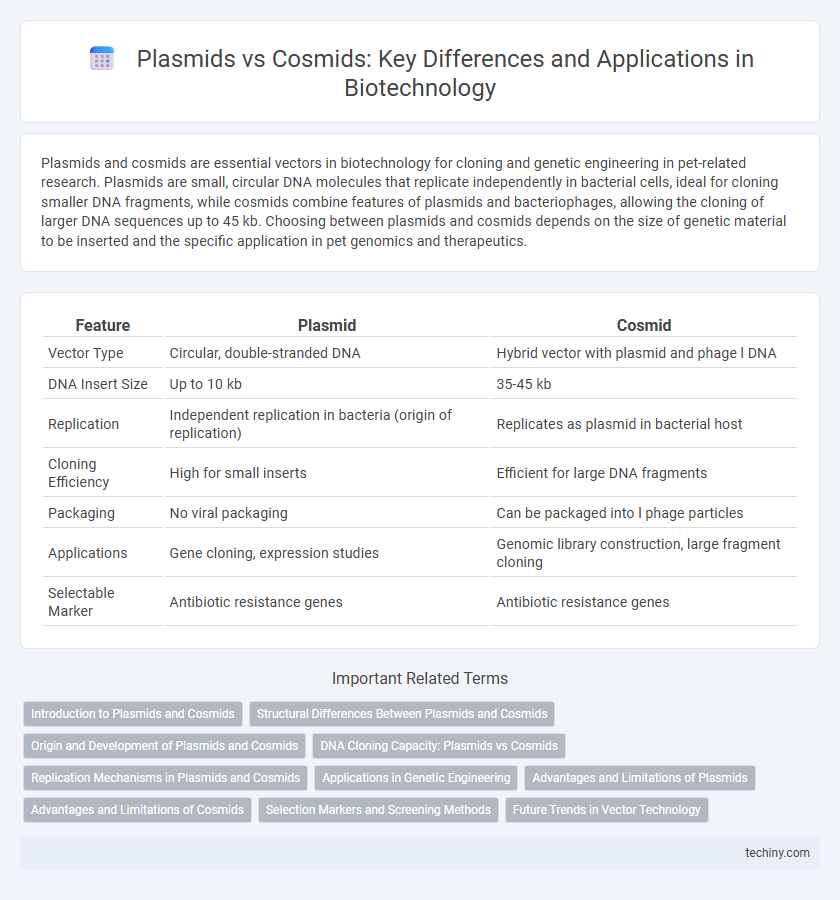Plasmids and cosmids are essential vectors in biotechnology for cloning and genetic engineering in pet-related research. Plasmids are small, circular DNA molecules that replicate independently in bacterial cells, ideal for cloning smaller DNA fragments, while cosmids combine features of plasmids and bacteriophages, allowing the cloning of larger DNA sequences up to 45 kb. Choosing between plasmids and cosmids depends on the size of genetic material to be inserted and the specific application in pet genomics and therapeutics.
Table of Comparison
| Feature | Plasmid | Cosmid |
|---|---|---|
| Vector Type | Circular, double-stranded DNA | Hybrid vector with plasmid and phage l DNA |
| DNA Insert Size | Up to 10 kb | 35-45 kb |
| Replication | Independent replication in bacteria (origin of replication) | Replicates as plasmid in bacterial host |
| Cloning Efficiency | High for small inserts | Efficient for large DNA fragments |
| Packaging | No viral packaging | Can be packaged into l phage particles |
| Applications | Gene cloning, expression studies | Genomic library construction, large fragment cloning |
| Selectable Marker | Antibiotic resistance genes | Antibiotic resistance genes |
Introduction to Plasmids and Cosmids
Plasmids are small, circular, double-stranded DNA molecules found naturally in bacteria, used as vectors for gene cloning due to their ability to replicate independently within host cells. Cosmids combine features of plasmids and bacteriophage lambda DNA, enabling the cloning of larger DNA fragments (up to 45 kb) compared to plasmids, which typically carry inserts less than 15 kb. These vectors play crucial roles in genetic engineering, with plasmids favored for small gene cloning and cosmids for constructing genomic libraries.
Structural Differences Between Plasmids and Cosmids
Plasmids are circular, double-stranded DNA molecules typically ranging from 1 to 200 kilobase pairs, whereas cosmids are hybrid vectors combining plasmid and phage l DNA elements, generally sized between 35 and 45 kilobase pairs. Plasmids contain an origin of replication and selectable markers but lack cos sites; cosmids include cos sites necessary for packaging DNA into l phage particles, enabling efficient cloning of larger DNA fragments. The structural incorporation of phage l cos sequences in cosmids facilitates the packaging of recombinant DNA into bacteriophage capsids, distinguishing them from the simpler, self-replicating plasmid architecture.
Origin and Development of Plasmids and Cosmids
Plasmids originated as naturally occurring, circular DNA molecules found in bacteria, playing a critical role in horizontal gene transfer and antibiotic resistance. Cosmids were developed as hybrid vectors by combining plasmid origins of replication with phage lambda packaging signals, enabling efficient cloning of larger DNA fragments. This innovation addressed plasmids' size limitations, enhancing genetic engineering and recombinant DNA technology applications.
DNA Cloning Capacity: Plasmids vs Cosmids
Plasmids typically accommodate DNA inserts up to 10 kilobases, making them ideal for cloning smaller gene sequences and regulatory elements. Cosmids combine features of plasmids and bacteriophage lambda, allowing them to carry larger DNA fragments ranging from 35 to 45 kilobases, thus enabling efficient cloning of substantial genomic libraries. The enhanced cloning capacity of cosmids makes them preferable for genomic mapping and complex gene studies compared to plasmids.
Replication Mechanisms in Plasmids and Cosmids
Plasmids replicate autonomously within bacterial cells using theta or rolling circle replication mechanisms, ensuring multiple copies per cell for gene cloning. Cosmids, hybrid vectors combining plasmid replication origins with bacteriophage l packaging signals, replicate like plasmids but can be packaged into phage particles for efficient DNA transfer. Both replication processes allow stable maintenance of recombinant DNA, but cosmids facilitate larger DNA fragment cloning due to their phage-derived packaging system.
Applications in Genetic Engineering
Plasmids serve as versatile vectors for gene cloning, gene expression, and recombinant protein production due to their small size and ease of manipulation. Cosmids, combining features of plasmids and bacteriophage l, enable the cloning of larger DNA fragments up to 45 kb, facilitating genomic library construction and large gene cluster analysis. Both vectors are essential in genetic engineering for different applications, with plasmids preferred for routine gene cloning and cosmids for handling extensive genetic material.
Advantages and Limitations of Plasmids
Plasmids offer high cloning efficiency and ease of manipulation, making them ideal for gene cloning and protein expression in biotechnology. Their small size enables rapid replication in host cells, but they have limited capacity for large DNA fragments, typically up to 15 kb. Plasmids often require antibiotic selection markers and may face stability issues in certain host strains, restricting their use in large-scale or high-complexity genetic engineering projects.
Advantages and Limitations of Cosmids
Cosmids combine features of plasmids and bacteriophage l, enabling efficient cloning of large DNA fragments up to 45 kb, which surpasses the typical 10 kb capacity of plasmids. Their ability to package DNA into phage particles facilitates high-efficiency transduction and stable propagation in host bacteria, making them ideal for genomic library construction. However, cosmids require specialized packaging extracts for in vitro phage assembly and display limitations in cloning extremely large DNA sequences exceeding 45 kb.
Selection Markers and Screening Methods
Plasmids typically use antibiotic resistance genes such as ampicillin or kanamycin as selection markers, enabling easy identification of transformed cells by growth on selective media. Cosmids combine features of plasmids and phages, often incorporating antibiotic resistance markers alongside additional elements like the lacZ gene for blue-white screening, which facilitates differentiation between recombinant and non-recombinant clones. Screening methods for plasmids primarily rely on antibiotic selection, whereas cosmids leverage both antibiotic resistance and colorimetric assays to enhance the efficiency of clone identification in molecular cloning experiments.
Future Trends in Vector Technology
Plasmids and cosmids remain fundamental vector tools in biotechnology, with emerging trends emphasizing enhanced capacity and versatility for gene cloning and therapy. Next-generation vectors integrate CRISPR-Cas systems and synthetic biology approaches to improve stability, targeting efficiency, and payload size beyond traditional plasmids and cosmids. Advances in vector engineering are driving personalized medicine, gene editing, and high-throughput screening applications toward more precise and scalable solutions.
Plasmid vs Cosmids Infographic

 techiny.com
techiny.com